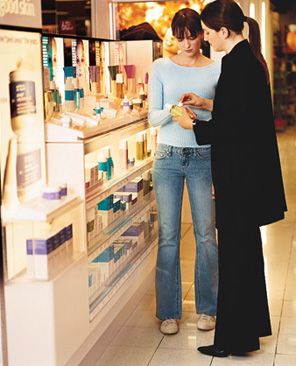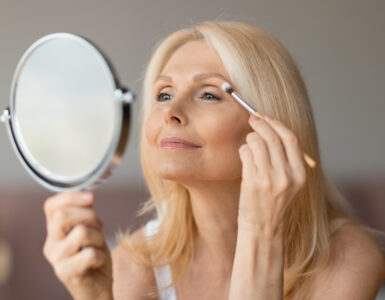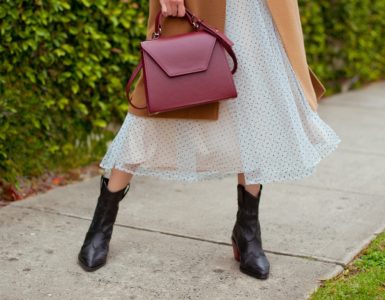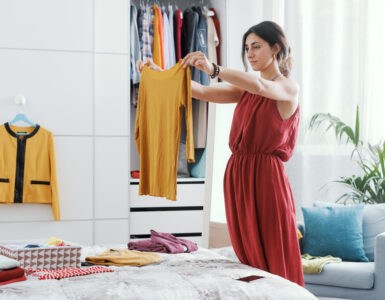Studio 5 Beauty & Style Contributor Holly Stone shares some tips on how to maneuver the make-up counters.
Department store make-up counters can be an intimidating black hole of products and diverse salespeople. Can you trust the sales staff to give you more than just a sales pitch? Can you be confident that you will be given expert advice for your individual needs?
Counter artists are trained first to sell products and they do this very well. Their training is often centered around selling to meet individual and department goals and how to promote the brand. There is little training on targeting your individual needs. If YOU aren’t clear on your needs, they will do their job and “sell” you what they think you need. Follow the tips below so you don’t walk away with buyer’s remorse, or even worse, with the wrong product you will have to return later. Shopping for cosmetics can be fun AND fruitful with some basic knowledge of how to maneuver the cosmetics counter.
IN PREPERATION:
1) Have a list ready.
All too often we are hooked in by bright colors or hefty claims. To avoid walking away from the counter with products you really didn’t need or being lured in by a gift with purchase that requires spending MORE, know exactly what you are looking for BEFORE you go looking.
2) Know your skin type and mention it right away.
Knowing your skin type will help guide the artist to select products that will work best on your skin. Artists aren’t usually trained to ask about or make an accurate assessment of skin type. However, they should have knowledge of how products work with specific skin types. If they “guess” your skin type incorrectly, the result may be a product that won’t perform sufficiently on your skin.
3) Tell your artist about your lifestyle.
Do you only spend 5 minutes on your make-up or are you the collection queen who has a drawer full of cosmetics and loves to experiment? By immediately expressingyour Will and Won’tmake up habits, you will be pointed in to the products and applications that will best suit your needs.
4) Don’t be afraid to ask questions.
There is NO dumb question. If you need more information, ask for it. It you don’t feel the artist has answered it sufficiently, ask them to clarify with another staff member. When you make a purchase, you should have NO lingering questions in your mind and should feel confident that your purchase will suit your needs.
SPECIFIC QUESTIONS FOR SPECIFIC PRODUCTS
Foundation Color
1) When suggesting color does your brandmatch skin tone or balanceskin tone?
Match implies a color that evens out your CURRENT complexion tone. Balance implies correcting any color thus possibly altering your skin’s tone to the most flattering tone on you.
Bonus Question:What are the undertones of your foundations: yellow or pink?
Yellow undertones offer balance and assist to restore complexion to a natural flesh tone
Pink undertones match existing skin tone and simply even out complexionIf brand has both, refer to your preference in question #1. If it has only one option, determine if that color option meets your expectations in a foundation.
Foundation/Concealer Formula
2) Is the coverage sheer, moderate or full?
Most artists are geared up to give you all the reasons WHY you should buy their brand of foundation (i.e. anti-aging, mineral based, SPF, smooth application, light diffusing). However, the most important characteristic of foundation is the coverage it will provide to meet your personal preference. Then, if the other benefits appeal to you they are a bonus.
Sheer=mattes skin, covers nothing.
Moderate=evens out mild tones, covers little.
Full= evens out full tones, covers much.Bonus Question:What skin type is this foundation best for?
This is your way of testing your artist’s listening skills. If you told her you have oily skin, and the foundation she recommends is for dry skin, she may not have the level of expertise needed to make effective recommendations for you.
It is possible to get a foundation that meets your preferred coverage AND your skin type and you shouldn’t settle until you have BOTH.
3) Do your concealers also have treatment ingredients?
This is where a multi-function product is highly recommended. If you are using a concealer for blemishes, find one that not only covers it, but treats the redness and raised bump too. For dark circles or under eye puffiness, find a concealer that has ingredients which target dark circle problems or reduces the puffiness as well as cover. This is a great way to stretch your dollar and get multiple benefits from one product.
Mascara
4) What effect does this formula provide?
Most brands differentiate themselves by their APPLICATORS. However, the determining factor in wearability of mascara is the FORMULA. The best mascaras specialize in one DOMINANT feature and then as a side note, list other possible benefits i.e. curls, defines, lengthens, separates, builds, flake-resistant. If the mascara has multiple features with not ONE standing out as dominant, be wary because there is no such thing as a mascara that provides ALL effects. Choose the mascara that touts the single feature most important to you: builds volume, lengthens lashes, separates, curls, flake-resistant, defining.
Powders
5) Are your powders triple-milled?
This describes the refining process the powder goes through to minimize the particle size. If the powder is anything less than triple-milled, it will appear more chunky on the complexion. The higher the milling process, the more velvety the powder appears. This is especially important to know with mineral-based cosmetics.
6) Will your cream based eye shadows crease WITHOUT powder over the top?
Some cream based shadows are meant as a primer and thus require a powder over the top to minimize creasing. Other cream based shadows are designed to be the actual replacement for a powder shadow and therefore have anti-creasing ingredients. Knowing the function (shadow or primer) of the cream eye shadow will help you maximize its benefits and get the effect you expect.
7) Please sanitize products/brushes before you apply on me.
This is a simple request that is important to make. If the artist wants to try a product on you (and they should always recommend doing so) request that the tools be SANITIZED. There is a difference between cleaning and sanitizing. Make sure you ask for the later to insure an antibacterial cleaning product is used.















Add comment